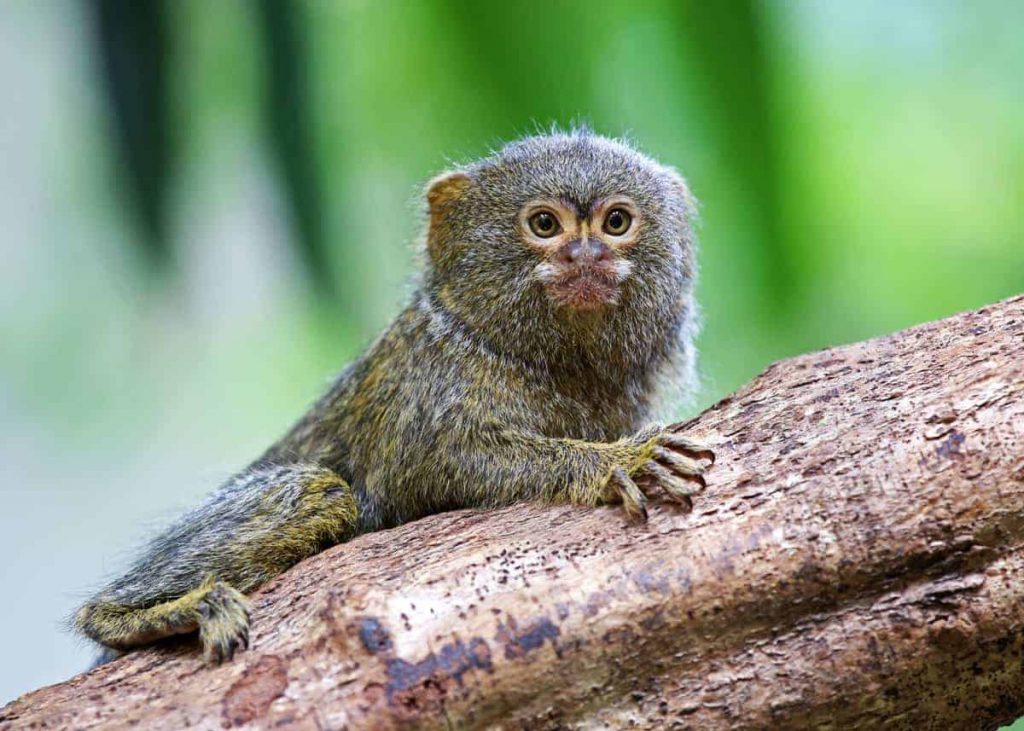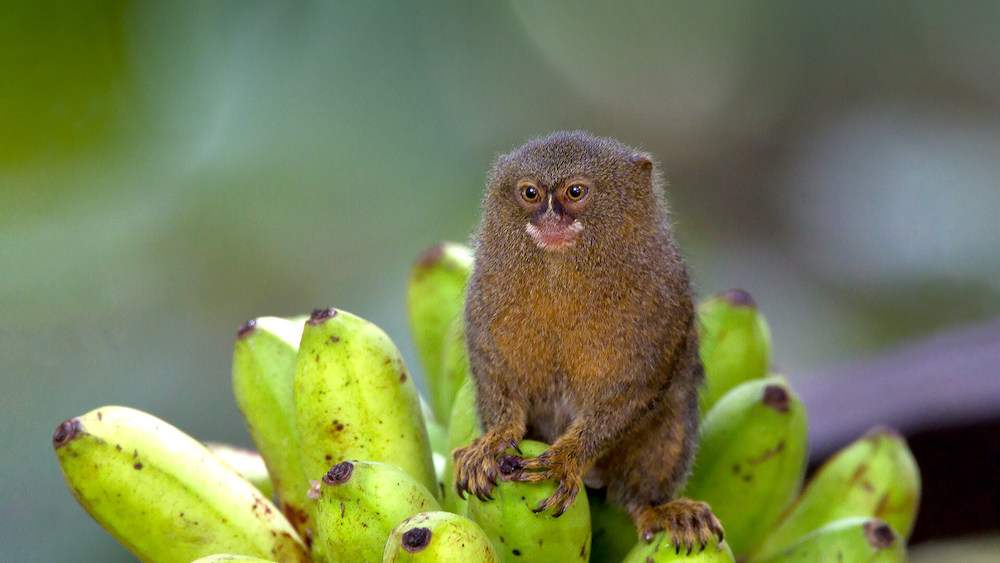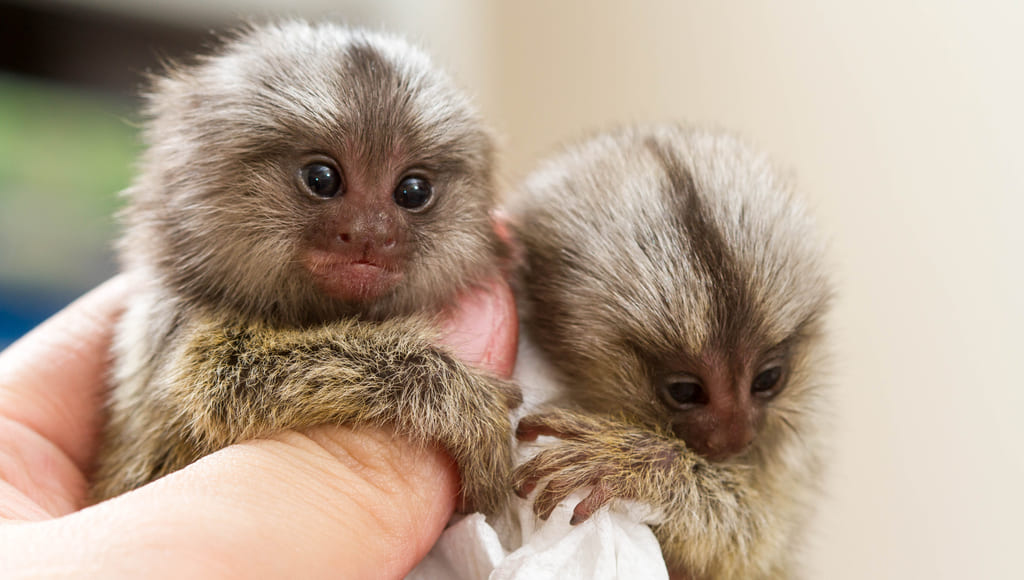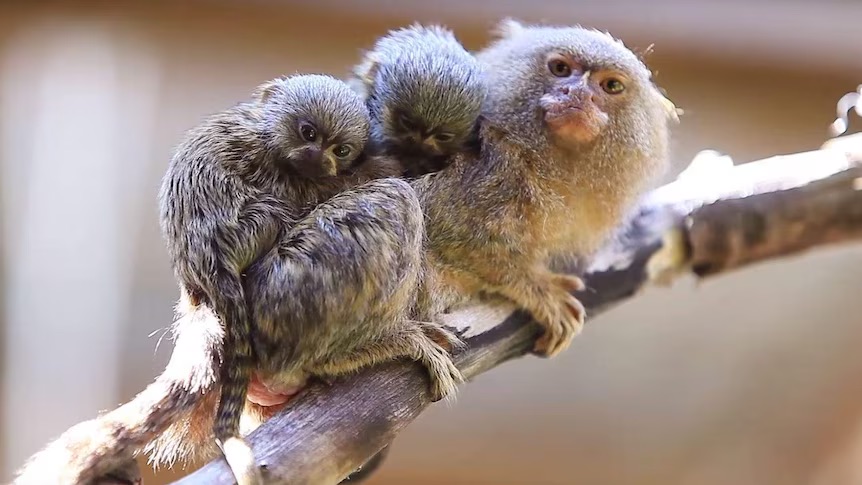Welcome, animal enthusiasts! Today, we’re diving into the fascinating world of smallest monkeys on the planet – the Finger Monkey aka Pocket Monkey. Now, you might be wondering, “What on earth is a Finger Monkey?” Well, let’s unravel this mystery together.
Finger Monkeys aka Pocket Monkeys, officially known as Pygmy Marmosets, are tiny creatures that have captured the hearts of many with their adorable looks and intriguing behaviors. These pint-sized primates hail from the lush rainforests of South America, where they lead a life full of gum-chewing (tree gum, that is), socialising, and, of course, monkeying around!
| Kingdom | Phylum | Class | Order | Family | Genus | Species |
|---|---|---|---|---|---|---|
| Animalia | Chordata | Mammalia | Primates | Callitrichidae | Callithrix | Callithrix pygmaea |
Now, why the nickname “Finger Monkey,” you ask? Picture this: a monkey so small that it can comfortably perch on your finger. That’s right!
These little fellas are about the size of a human finger, hence the name. But don’t let their size fool you. These mini monkeys are packed with personality and have a lot more to them than meets the eye.
So, buckle up as we embark on this exciting journey to explore the life and times of the Finger Monkey. From their diet of tree gum to their unique social structure, we’ve got a lot to cover. Let’s get started, shall we?
Table of Contents
- 1. Physical Characteristics of Finger Monkey
- 2. Habitat and Distribution of Finger Monkey
- 3. Behavior and Lifestyle of Finger Monkey
- 3.1 Social Structure of Finger Monkey and their Group Dynamics
- 3.2 Communication Methods Used by Finger Monkey
- 3.3 Daily Activities
- 3.4 Breeding Habits and Parental Care
- 4. Diet and Feeding Habits
- 5. Threats and Conservation
- 6. Finger Monkeys as Pets
- 7. Interesting Facts About Finger Monkey and Misconceptions
- 8. Conclusion
- 9. Frequently Asked Questions on Finger Monkey
Physical Characteristics of Finger Monkey
| Physical Characteristic | Finger Monkey |
|---|---|
| Size (Body Length) | 4.6 to 6.2 inches |
| Size (Tail Length) | 6.8 to 9 inches |
| Weight | 3.5 to 4.2 ounces |
| Fur Color | Brownish-gold on the back, creamy on the underside, with white patches around eyes and ears |
| Lifespan (In the Wild) | 11 to 12 years |
| Lifespan (In Captivity) | Up to 16 years |
Let’s talk about the physical characteristics of our tiny friends, the Finger Monkeys. These little guys are the epitome of the phrase “good things come in small packages.”
Firstly, their size. Picture a soda can. Now, imagine a monkey that’s even smaller than that. That’s right!
Adult Finger Monkeys typically measure between 4.6 to 6.2 inches in length. And that’s not including their tail, which can add another whopping 6.8 to 9 inches.
Despite their small stature, these monkeys are perfectly formed, with all the features you’d expect in a primate, just in a mini version.
Now, let’s talk about weight. If you’ve ever held five quarters in your hand, you’ve held the equivalent weight of a Finger Monkey.
These lightweight creatures usually weigh between 3.5 to 4.2 ounces. That’s lighter than a deck of cards!
Moving on to their appearance, Finger Monkeys are covered in fur that’s a delightful mix of colors.
Their backs are usually covered in brownish-gold fur, while their undersides feature a lighter, creamy color. They also have distinctive white patches around their eyes and ears, giving them a somewhat masked look.
It’s like they’re always ready for a masquerade!
Lastly, let’s touch on their lifespan.
In the wild, these monkeys can live up to 11 to 12 years, which is quite impressive for such small creatures. However, in captivity, where they’re safe from predators and have a steady food supply, they can live up to 16 years.
That’s a lot of time for these tiny primates to leave a big impression!
Habitat and Distribution of Finger Monkey
Now that we’ve got a handle on what Finger Monkeys look like, let’s take a virtual trip to their home – the Amazon rainforest.
Finger Monkeys are true rainforest dwellers.
They love the lush, green canopy of the Amazon, which stretches across several countries in South America. From Brazil to Ecuador, Colombia to Peru, these tiny primates have made themselves at home in this vast tropical paradise.
Their preferred real estate? Bamboo forests and areas near river edges. Why, you ask? Well, these habitats provide them with their favorite food – tree gum.
These monkeys are gum-aholics, and the trees in these areas are like their personal gum factories.
Let’s paint a picture of their living conditions.
Imagine a dense, green forest with towering trees and a symphony of sounds from various creatures. The air is humid, and the scent of earth and leaves fills your nostrils. Now, look closely at a bamboo tree.
Do you see a small creature, almost camouflaged against the bark? That’s our Finger Monkey, happily gnawing away at the tree bark to reach the gum inside.
Here’s a fun fact: Finger Monkeys are excellent climbers. They use their sharp claws to scamper up trees and can leap impressive distances between branches.
Behavior and Lifestyle of Finger Monkey
Alright, folks, it’s time to dive into the social lives of our tiny friends, the Finger Monkeys. These little primates lead quite an interesting life, filled with socializing, communicating, and, of course, a whole lot of tree gum munching!
Social Structure of Finger Monkey and their Group Dynamics
Finger Monkeys are social butterflies… well, social monkeys, to be precise.
They live in groups, known as troops, which typically consist of 2 to 9 members. This usually includes a dominant male, a breeding female, and their offspring.
Communication Methods Used by Finger Monkey
When it comes to communication, Finger Monkeys have quite an extensive repertoire.
They use a combination of vocalizations, body language, and even chemical signals to communicate with each other.
From high-pitched calls to alert their troop of danger, to releasing scents to mark their territory, these monkeys are quite the communicators!
Daily Activities
A day in the life of a Finger Monkey involves a mix of feeding, grooming, playing, and resting. They start their day with a hearty breakfast of tree gum, followed by some grooming and socializing with their troop.
Playtime is also an important part of their day, especially for the young ones. And after a busy day, they retreat to their sleeping sites in the trees for some well-deserved rest.
Breeding Habits and Parental Care
When it comes to breeding, Finger Monkeys have a unique system. Only the dominant female in the troop is allowed to breed, usually with the dominant male.
She gives birth to twins twice a year, which is quite unusual for monkeys.
Parental care is a group effort in Finger Monkey troops. While the mother nurses the babies, the father and other members of the troop help in carrying and looking after the young ones. It’s a real team effort!
Diet and Feeding Habits
Let’s talk about the dining habits of our tiny friends, the Finger Monkeys. These little primates have a rather unique diet, which includes tree gum, insects, and fruits.
What’s on the Menu?
The main item on a Finger Monkey’s menu is tree gum. They just can’t get enough of it! They also supplement their diet with insects and fruits, making them omnivores.
Now, you might be wondering, “How do they extract tree gum?”
Well, these clever monkeys use their sharp teeth to gnaw holes into tree bark, causing the tree to release gum. They then use their long tongues to lap up this sticky treat. It’s a bit like their version of a candy store!
Role of Finger Monkey in the Ecosystem
Apart from their unique feeding habits, Finger Monkeys also play an important role in their ecosystem. They act as pollinators and seed dispersers, helping to maintain the health and diversity of their rainforest home.
When they feed on fruits, they often carry seeds away from the parent plant, dispersing them in different locations through their droppings. This helps in the propagation of these plants.
Similarly, when they feed on nectar, they end up transferring pollen from one flower to another, aiding in plant reproduction.
Threats and Conservation
As we continue our journey into the world of Finger Monkeys, it’s important to address the challenges these tiny primates face. From habitat loss to the pet trade, these monkeys are up against some serious threats.
Threats to Finger Monkeys
The biggest threat to Finger Monkeys is habitat loss. As the Amazon rainforest continues to be cleared for agriculture and urbanization, these monkeys are losing their homes at an alarming rate.
Another major threat is the pet trade. Due to their small size and cute appearance, Finger Monkeys are often captured and sold as pets.
This not only disrupts their social structure but also exposes them to stress and diseases.
Conservation Status and Efforts
Despite these threats, there’s hope for our tiny friends. Finger Monkeys are currently listed as “Least Concern” on the IUCN Red List, thanks to their wide distribution and adaptability.
However, conservation efforts are still crucial to ensure their survival.
Several organizations are working to protect the Amazon rainforest and its inhabitants, including the Finger Monkeys.
These efforts include habitat preservation, research, and public education about these monkeys and their importance to the ecosystem.
Laws and Regulations
When it comes to keeping Finger Monkeys as pets, there are strict laws and regulations in place. In many countries, it’s illegal to keep these monkeys as pets without a special permit.
These laws are designed to protect these creatures from exploitation and to ensure their welfare.
Finger Monkeys as Pets
Now, let’s address a question that’s probably on many of your minds: “Can I keep a Finger Monkey as a pet?”
While these tiny primates might seem like the perfect pocket-sized companions, there are several challenges and considerations to keep in mind.
Challenges and Considerations
- Firstly, Finger Monkeys are wild animals, not domesticated pets. They have specific needs and behaviors that can be difficult to cater to in a home environment.
- Secondly, they are social creatures that live in groups. Keeping a Finger Monkey alone can lead to stress and behavioral issues.
- Lastly, the pet trade poses a serious threat to wild populations of Finger Monkeys. By buying these monkeys as pets, you could inadvertently be supporting illegal wildlife trafficking.
Care Requirements
If you’re still considering keeping a Finger Monkey as a pet (and you have the necessary permits), it’s important to understand their care requirements.
Finger Monkeys need a diet rich in tree gum, insects, and fruits. They also require a large, enriched enclosure that mimics their natural habitat. This includes plenty of vertical space for climbing and jumping, as well as hiding spots for resting.
Social interaction is also crucial for these monkeys. They need the company of their own kind to thrive.
Ethical Considerations
Keeping wild animals as pets raises several ethical considerations. It’s important to consider the welfare of the animal and the impact on wild populations.
Interesting Facts About Finger Monkey and Misconceptions
As we near the end of our journey into the world of Finger Monkeys, let’s spice things up with some interesting facts and clear up some common misconceptions about these tiny primates.
Facts About Finger Monkey
- Tiny Titans: Finger Monkeys are the smallest monkeys in the world. They’re so small that they can sit on a human finger, hence the name!
- Gum Gourmets: These monkeys have a unique diet. They love tree gum and have special teeth to gnaw holes in tree bark to get to it.
- Family Matters: Finger Monkeys live in close-knit family groups, known as troops. These troops usually consist of a dominant male, a breeding female, and their offspring.
- Double Trouble: Unlike most monkeys, Finger Monkeys usually give birth to twins.
- Longevity Leaders: Despite their small size, Finger Monkeys can live up to 16 years in captivity, which is quite impressive for such tiny creatures.
Common Misconceptions About Finger Monkey
- Pet Potential: One common misconception is that Finger Monkeys make good pets. However, these are wild animals with specific needs that can be difficult to meet in a home environment.
- Solo Creatures: Some people believe that Finger Monkeys are solitary creatures. In reality, they are highly social and live in groups.
- Easy to Care For: Another misconception is that Finger Monkeys are easy to care for. However, they require a specific diet, a large and enriched habitat, and social interaction with their own kind.
Conclusion
And there you have it, folks! We’ve journeyed together through the fascinating world of Finger Monkeys, exploring everything from their physical characteristics to their unique lifestyle.
We’ve learned that these tiny primates, also known as Pygmy Marmosets, are the smallest monkeys in the world, fitting comfortably on a human finger.
They hail from the lush Amazon rainforest, where they live in close-knit family groups and enjoy a diet of tree gum, insects, and fruits.
We’ve also discussed the challenges these monkeys face, including habitat loss and the pet trade, and the importance of conservation efforts to ensure their survival.
We’ve debunked some common misconceptions about keeping these creatures as pets and highlighted the ethical considerations involved.
In conclusion, Finger Monkeys are truly remarkable creatures. They remind us of the incredible diversity of life on our planet and the importance of protecting it. These tiny primates may be small in size, but they have a big role to play in their ecosystem.
Frequently Asked Questions on Finger Monkey
A Finger Monkey, also known as a Pygmy Marmoset, is the smallest monkey in the world. They are native to the Amazon rainforest in South America and are known for their small size, which is about the size of a human finger, hence the nickname.
Finger Monkeys have a unique diet primarily consisting of tree gum. They also supplement their diet with insects and fruits. They have special teeth that allow them to gnaw holes into tree bark to extract the gum.
While Finger Monkeys might seem like cute and interesting pets, they are wild animals with specific needs that can be difficult to meet in a home environment. In many countries, it’s illegal to keep these monkeys as pets without a special permit. It’s always best to respect wild animals and their natural habitats.
The biggest threats to Finger Monkeys are habitat loss and the pet trade. As the Amazon rainforest continues to be cleared for agriculture and urbanization, these monkeys are losing their homes. Additionally, due to their small size and cute appearance, they are often captured and sold as pets, disrupting their social structure and exposing them to stress and diseases.
Supporting conservation efforts is crucial to protect Finger Monkeys. This includes habitat preservation, research, and public education about these monkeys and their importance to the ecosystem. It’s also important to avoid supporting the pet trade of these animals. Instead, we can learn about them and appreciate them in their natural habitat.
Read More Interesting Articles:
- 30 Amazing Animal Superpowers That You Wish You Had
- Are Dolphins Evil? 12 Reasons Why We Think So!
- 15 Most Beautiful & Cute Jellyfish Species In The World
- 15 Amazing Facts About Point Nemo: Most Remote Place on Earth
- Everything About Chaneque: Mexican Folklore Legendary Creatures









